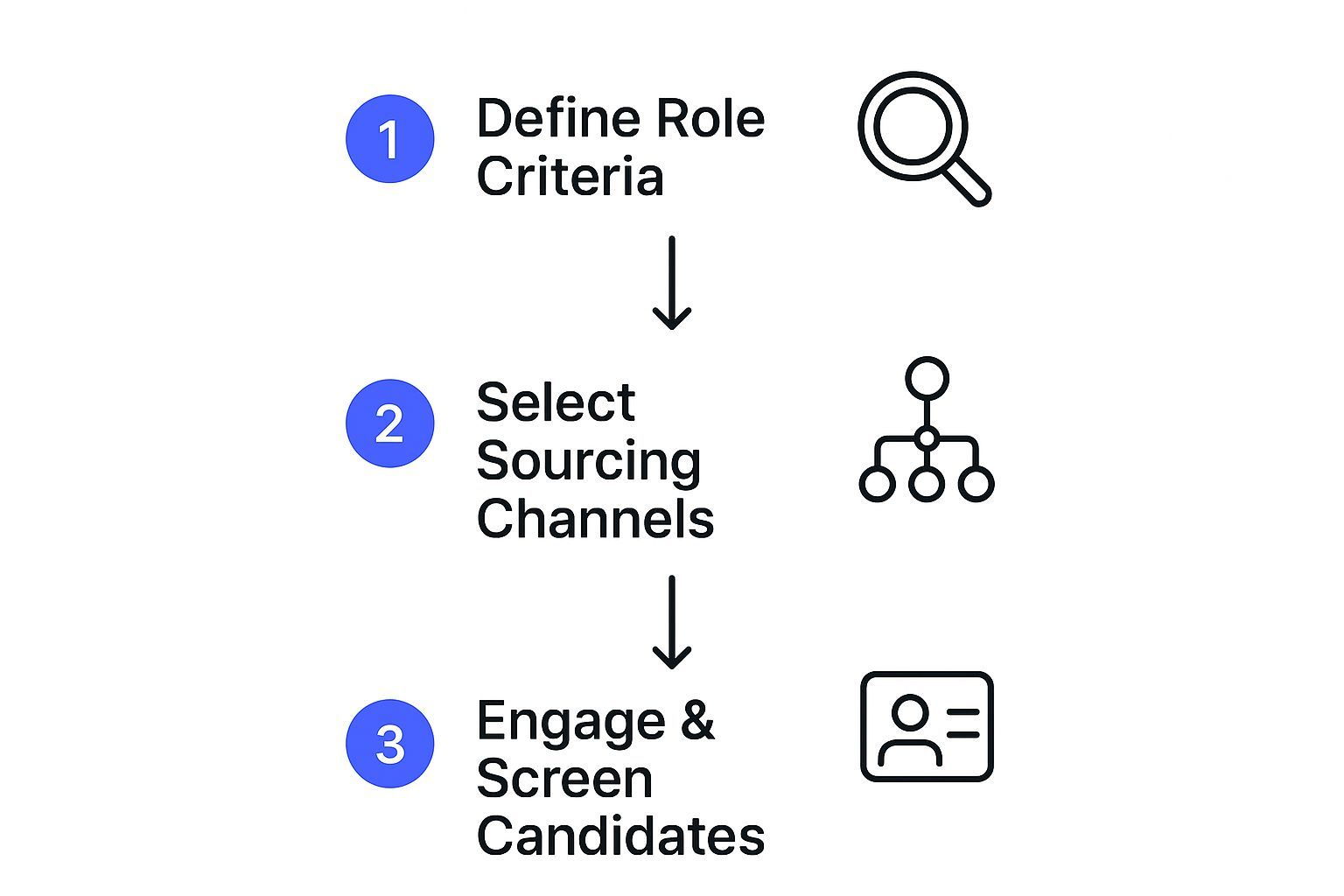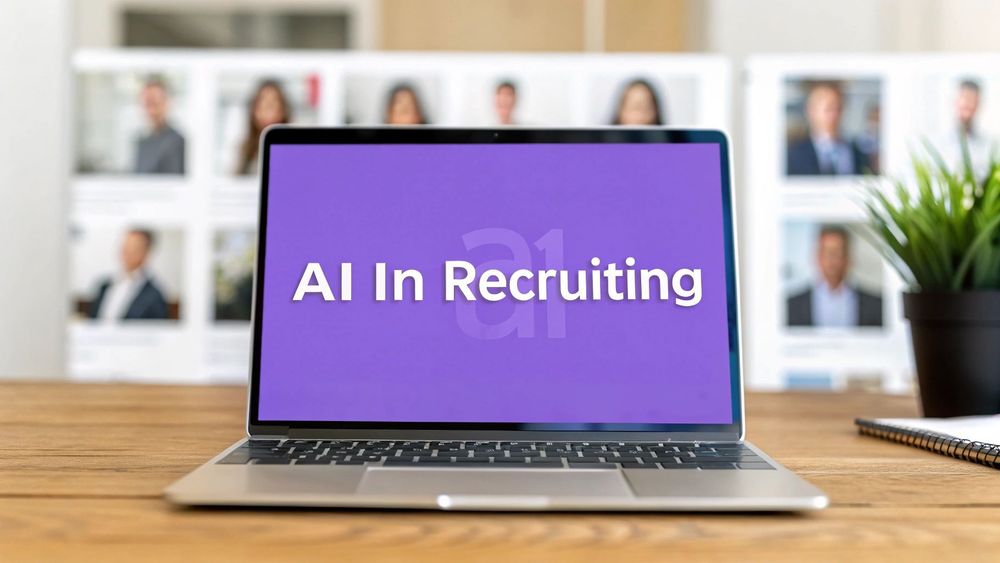Let’s be honest: posting a job ad and hoping for the best is a strategy from a bygone era. To find, attract, and hire the talent that truly moves the needle, you need a proactive, multi-channel game plan. The smartest approach today combines tried-and-true methods, like employee referrals, with modern techniques like social media sourcing and smart, no-code tools to build a candidate pipeline that's always full.
This guide will walk you through the traditional sourcing methods and show you how to supercharge them with a modern, one-click workflow.
Why Your Sourcing Strategy Needs a Rethink

The old 'post and pray' method of recruiting is dead. In a competitive market, the professionals you really want aren't endlessly scrolling through job boards. They're busy excelling in their current roles. If you're only looking at inbound applications, you're seeing a tiny fraction of the available talent and almost certainly missing the best people.
This passive approach puts you on the back foot. While you wait for applications to trickle in, your competitors are actively finding and engaging high-value candidates right where they are online—on platforms like LinkedIn, GitHub, and other professional communities.
The Modern Recruiting Challenges
Today's recruiters face a different kind of challenge, defined by fierce competition and a high demand for niche skills. A sophisticated plan of attack is no longer optional.
- Intense Competition: Top-tier candidates often field multiple offers. You have to be fast and make a memorable impression.
- Specialized Skill Demand: Finding the perfect mix of technical prowess and soft skills for a niche role is like finding a needle in a haystack.
- Passive Candidate Dominance: The most sought-after professionals aren't actively looking. You have to find them and give them a compelling reason to engage.
This new reality has created a huge need for specialized roles within recruiting. In fact, demand for talent acquisition specialists shot up by a staggering 87% in just one year as companies scrambled to find experts to navigate this landscape.
The problem isn't a lack of talent; it's a lack of visibility. Your ideal candidate is out there, but they won't stumble upon your job post by accident. A proactive, multi-channel sourcing strategy is essential for survival.
It’s time to ditch the soul-crushing manual work. Spending hours sifting through profiles, copying and pasting data into spreadsheets, and juggling messy lists is a massive time sink. To compete, you need modern, efficient workflows that free you up to do what actually matters: building relationships with the people who will drive your company forward.
Mastering the Foundations of Candidate Sourcing

Before diving into automation, it's crucial to master the basics. Think of these foundational sourcing channels as the bedrock of your talent pipeline. Understanding the manual grind is the first step to appreciating how the right tools can provide a massive competitive edge.
The Traditional Method: Manual and Time-Consuming
Job boards are a common starting point, but simply posting a description and waiting is a recipe for disappointment. To succeed, you must treat your job listing like a marketing asset, optimized with keywords top candidates use in their searches. A solid employee referral program can also be a recruiter's secret weapon, but managing it manually is an administrative nightmare.
Networking events, both virtual and in-person, remain a goldmine for genuine connections. However, the follow-up process is incredibly time-consuming.
Let's break down the manual work involved:
- Job Board Management: Constantly refreshing posts, tracking applicants in messy spreadsheets, and manually sifting through hundreds of often irrelevant applications.
- Referral Program Administration: Tracking who referred whom, chasing down bonus payments, and sending endless reminders to your team to participate.
- Networking Follow-up: Returning from an event with a stack of business cards or a list of new connections, then spending hours manually researching each person, entering their data into a spreadsheet, and crafting personalized follow-ups.
This is the frustrating reality of traditional sourcing. The process is fragmented, mind-numbingly repetitive, and completely dependent on manual data entry. Every hour spent copying and pasting from a LinkedIn profile into a spreadsheet is an hour not spent talking to a high-potential candidate.
The Modern Alternative: One-Click Simplicity with ProfileSpider
The challenge for today's recruiters is to keep the human touch of traditional sourcing while ditching the soul-crushing manual tasks. This is where a modern, no-code tool like ProfileSpider comes in.
Instead of manually building lists from events or referrals, you can automate the data collection. For example, after connecting with new contacts on LinkedIn post-event, you can visit their profiles or a search result page and use ProfileSpider to extract all their information with a single click.
This instantly turns a pile of business cards or a list of names into a clean, structured database, ready for outreach. You can learn more about how modern tools are designed for streamlining recruiter workflows and giving you back your most valuable asset: time.
Finding Hidden Talent on Social Platforms

Your dream candidates probably aren't scrolling through job boards. They’re busy contributing to open-source projects on GitHub, sharing innovative designs on Behance, or leading discussions in niche Reddit communities. Tapping into these spaces is the art of modern social sourcing.
The Traditional Method: A Manual Grind
The old-school way involves manually digging through these platforms, one profile at a time. A recruiter looking for a Python developer might start by using GitHub's search filters to find people contributing to popular libraries. But that’s just the beginning.
The typical manual workflow is a real slog:
- Platform Hopping: Guessing where your ideal candidates (engineers, designers, marketers) hang out online.
- Keyword Guessing: Using each platform's unique search quirks to try and surface relevant profiles.
- Profile Diving: Manually clicking into every single profile to assess if they’re a potential fit.
- Copy-Paste Hell: Transferring names, profile URLs, and notes into a separate spreadsheet, one field at a time.
- Contact Info Hunt: Scouring the internet for an email address or another way to get in touch, which often leads to a dead end.
Each profile discovered means another 5-10 minutes of tedious data entry. This scattergun approach is exhausting, and the results are wildly inconsistent. If you're serious about engaging high-quality candidates, especially passive ones, you need more than manual effort. It requires effective strategies for prospecting on LinkedIn and beyond.
The Modern Alternative: One-Click Profile Extraction
Now, what if you could turn that entire manual grind into a single click? This is where an AI-powered, no-code scraper like ProfileSpider completely changes the game.
Imagine you're a recruiter who has found a list of promising software engineers on GitHub. Instead of spending hours copying and pasting their details, you simply navigate to the page and click the ProfileSpider extension.
In seconds, ProfileSpider extracts every profile on that page into a clean, structured list. You instantly have names, job titles, profile links, and any available contact details. This single action cuts out hours of manual work, letting you build comprehensive candidate pipelines in minutes, not days. It bridges the gap between finding talent and actually starting a conversation.
Want to see how simple it is? You can check out some interactive test profiles here.
Using AI to Automate Your Sourcing Workflow
Manual sourcing is a grind. We've all been there—spending hours sifting through profiles, copying and pasting data, and wrestling with outdated contact info. It’s a massive bottleneck preventing you from doing the real work of recruiting.
The Traditional Method: Manual Data Entry
Imagine you need to build a pipeline for a Senior Python Developer. The old way means spending your day on GitHub, clicking profile after profile, hoping to find an email address. The administrative load is huge, and the risk of human error is always present. Every minute you spend on data entry is a minute you're not spending engaging a high-value candidate.
Thankfully, there’s a much smarter way to operate.
The Modern Alternative: Smart Automation with ProfileSpider
The future of recruiting is about using AI-powered tools to eliminate repetitive tasks and scale your efforts. The idea is simple: automate the most time-consuming parts of sourcing—like data collection—so you can focus on building relationships.
The industry is moving fast. Companies already using AI-driven screening report hiring cycles that are 46% faster than traditional methods. You can dig into more of these recruiting trends and statistics on TalentMSH.com.
This diagram breaks down the steps of a modern sourcing process.

Automation tools like ProfileSpider completely supercharge the "Select Sourcing Channels" step, turning hours of manual research into a task that takes seconds.
Let’s compare the old-school manual approach with the new, AI-powered way.
Manual Sourcing vs AI-Powered Sourcing with ProfileSpider
| Sourcing Task | Traditional Manual Method | Automated Method with ProfileSpider |
|---|---|---|
| Data Collection | Individually copy-pasting names, titles, and company info from each profile into a spreadsheet. | One-click extraction of all profile data from a search results page on LinkedIn, GitHub, etc. |
| Contact Finding | Manually searching each profile for an email or social link, often with low success rates. | AI automatically scans for and finds available contact details like emails and social profiles. |
| Organization | Building and formatting a spreadsheet from scratch, with a high chance of formatting errors. | Data is instantly organized into a clean, structured list, ready for export to CSV, Excel, or your ATS. |
| Time Investment | Hours or even days to build a sizable candidate list for a single role. | Minutes to build a list of dozens or even hundreds of qualified candidates. |
| Scalability | Extremely difficult to scale. Sourcing from multiple platforms at once is a logistical nightmare. | Effortlessly source profiles from multiple platforms like LinkedIn, Facebook, and GitHub without getting bogged down. |
The difference is night and day. Automation doesn't just make you faster; it makes you more strategic. With ProfileSpider, you run a search on a platform like LinkedIn, and once you have a page full of potential candidates, you just click a button. The AI pulls all crucial data—names, job titles, companies, and contact info—into a clean list. No more copy-pasting, no more messy spreadsheets.
This modern approach delivers serious benefits:
- Incredible Speed: Build robust candidate lists in minutes, not days.
- Enhanced Accuracy: AI extraction minimizes the human error common in manual data entry.
- Effortless Scale: Source from platforms like LinkedIn, GitHub, and Linktree without the administrative burden.
For non-technical recruiters and sales pros, this is a game-changer. It empowers you to source more effectively, build better pipelines, and make hires faster.
Your Next Hire Could Be Anywhere in the World
In a remote-first world, your physical address matters less. The best person for the job is no longer limited to a 30-mile radius; they could be anywhere, and a global sourcing strategy is how you find them. This approach lets you tap into incredible talent hubs all over the globe, from software developers in Eastern Europe to designers in South America.
But global sourcing brings new headaches: juggling time zones, cultural nuances, and a confusing landscape of international professional networks.
The Problem with Doing it All by Hand
Trying to manually build a global talent pipeline is a massive, soul-crushing task. The sheer volume of profiles on a platform like LinkedIn can feel overwhelming. Imagine trying to identify and track promising software engineers in three different countries by hand.
You'd burn countless hours:
- Searching and filtering profiles across endless geographic regions.
- Manually copying and pasting every detail into spreadsheets that quickly spiral out of control.
- Struggling to keep data clean and consistent across different talent pools.
This manual grind is slow and a recipe for mistakes. It's a big deal, especially when 71% of hiring teams are already recruiting internationally to deal with talent shortages. You can dig deeper into these recruiting statistics from SelectSoftware Reviews.
The old way of sourcing just can't keep up. Every hour you spend on manual data entry is an hour you're not spending building relationships with top international candidates.
Automating Your Global Reach with ProfileSpider
This is where a tool like ProfileSpider changes the game. It smashes geographic barriers and eliminates the manual labor of global sourcing. Instead of getting buried in spreadsheets, you can focus on strategy.
With this one-click profile scraper, you can instantly pull profiles from international talent pools. Just run a search for your target role in a specific country on LinkedIn, and ProfileSpider grabs all the relevant candidate data in seconds.
This is how you build a rich, diverse, and perfectly organized global candidate database without the manual effort. It turns a once-impossible task into a simple, repeatable workflow.
Sourcing Questions We Hear All the Time
Even with the best strategy, some questions always come up. Effective sourcing is about having solid answers to the most common challenges.
How Should I Approach Passive Candidates?
The biggest mistake with passive candidates is sounding like every other recruiter. They aren't looking for a job, so a generic job description will be ignored. Your first message needs to be about them. Mention a specific project you saw on their GitHub or an insightful comment they made in a professional group. The goal is to start a real conversation and build rapport.
A great message to a passive candidate feels less like a sales pitch and more like a genuine compliment from a peer. It shows you've done your homework and respect their work.
How Can I Source for Niche Roles on a Budget?
Hunting for specialized talent can feel impossible without a big budget. But you can find top-tier candidates by focusing on niche online communities. Forget big job boards; look for specialized subreddits, Slack channels, or industry forums where these pros hang out.
The next step is to efficiently gather their contact info. A no-code tool like ProfileSpider is a game-changer here. You can pull profile details from these niche platforms with a single click, letting you build a highly targeted list of experts without paying for pricey database subscriptions.
What Are the Most Important Sourcing Metrics to Track?
If you're not measuring your sourcing efforts, you're guessing. A few key metrics will give you a clear picture of what's working.
- Source of Hire: This tells you which channels—referrals, LinkedIn, GitHub—are delivering the candidates who actually get hired.
- Time-to-Fill: This highlights bottlenecks in your process by tracking how long it takes to fill a role from the start of sourcing.
- Offer Acceptance Rate: A low rate can be a red flag, pointing to issues with your outreach, compensation, or candidate experience.
Keeping an eye on these numbers gives you a real-time dashboard for your sourcing strategy. If you have more specific questions about tools or techniques, explore our detailed ProfileSpider FAQ section for more answers.




